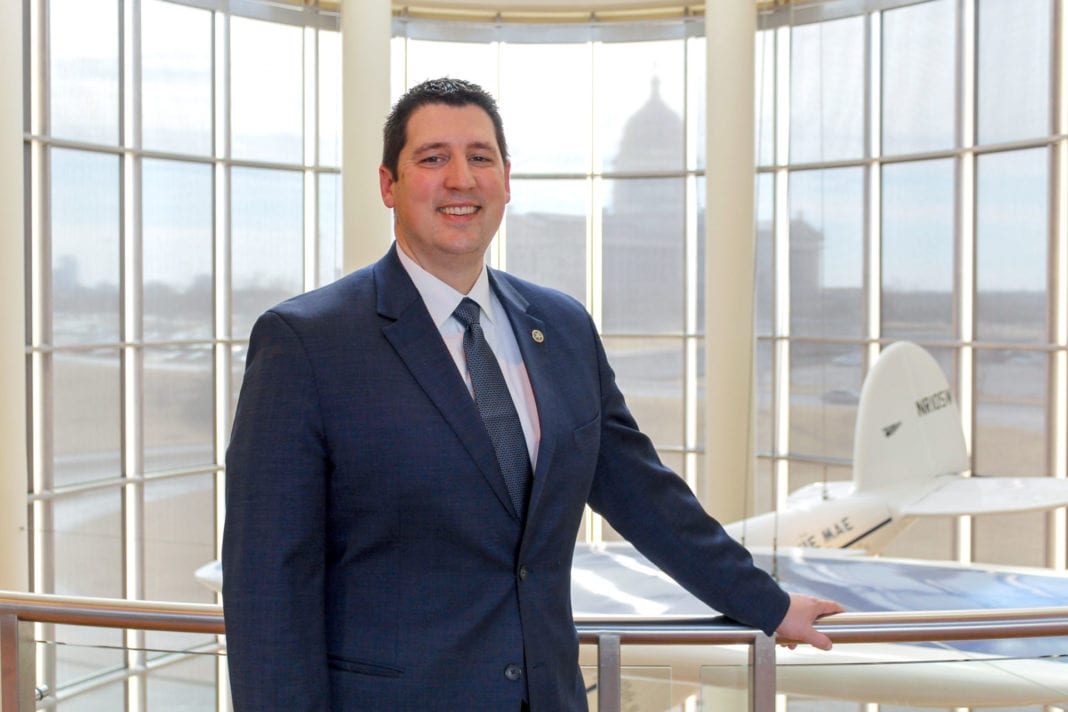In 2020, Trait Thompson was unanimously selected by the Oklahoma Historical Society’s board of directors to take the helm as executive director. Prior to that, he spearheaded a multi-million dollar restoration project, was a political advisor, and worked in the telecom and business consulting fields. Thompson has also been an adjunct professor at three universities in Oklahoma. We caught up with Thompson and got his thoughts on …
… what led him to OHS.
Since I started my career in state government over ten years ago, I have had the pleasure of working with the Oklahoma Historical Society and Dr. Blackburn [the previous executive director]. When I transitioned to managing the restoration of the Oklahoma State Capitol in 2014, I came to rely on the agency for historical drawings of the building, archival research and consultation on the architectural plans for restoration activities. It was through this work that I really got to know the incredible staff members and came to truly appreciate the mission of the agency. When I learned that Dr. Blackburn was planning to retire, I had a conversation with him to determine if he thought my skill set would be conducive to success as his potential successor. He complimented me on my passion for Oklahoma history and, given my knowledge of state government and the administrative skill I possessed in leading the Capitol restoration project, he thought I would be a quality candidate for the job.
… a day in the life.
If I am not traveling, my days usually involve quite a few meetings. I may meet with staff members to go over our budget for a particular project we’re working on or game plan for a future event at one of our sites. We have been focusing on strategic planning for the agency, so I carve out time each week to meet with our directors on that topic. Since the legislature is in session, it’s not uncommon for me to walk across the street to the Capitol to meet with a representative or senator about our budget or a bond issue we’re trying to get authorized.
I spend time working with our board members. Sometimes I am asked to speak to a group on Zoom or in person, and I also write columns for a couple of publications. I take time to get together with our donors from time to time and discuss opportunities to fund the work we are doing at the OHS. Much of my time lately has been spent working with our staff on the Oklahoma Museum of Popular Culture (OKPOP) in Tulsa. We are planning to open OKPOP in 2022 and there is much still to do, including completing construction on the building.
… his accomplishments.
In my career, I am most proud of the successful restoration of the Oklahoma State Capitol. I assumed the project manager role on that job in 2014, just after the first bond issue had passed the legislature. For six years, I shepherded the project and was the only full-time employee in state government dedicated to it. The Capitol was in terrible condition when we started. Today, with less than a year to the project’s completion, the exterior project has been finished and the building is completely water tight. The building has been modernized for today’s usage, all while maintaining its historic character. Best of all, the project will be completed ahead of schedule and on budget.
While I am still getting my feet under me at OHS, I am most proud so far of getting our podcast started again, A Very OK Podcast. It was a priority for me to get it started again to fulfill one of the planks of our mission statement, which is to share Oklahoma’s history.
… his enthusiasm for restoration and preservation.
Our built environment is one of the few tangible connections we have to our past. When we walk into a historic building or historic home, we are able to experience what it must have felt like to be in that place at a particular point in time. Standing in an old building or being in the midst of a historic landmark brings history alive in a way that is difficult to replicate in other ways. There is a quote by John Ruskin that perfectly captures how I feel about these places: “When we build, let us think that we build forever. Let it not be for present delight nor for present use alone. Let it be such work as our descendants will thank us for; and let us think, as we lay stone on stone, that a time is to come when those stones will be held sacred because our hands have touched them, and that men will say, as they look upon the labor and wrought substance of them, ‘See! This our fathers did for us.’”
… his love for Oklahoma.
Oklahoma is an incredible place with a cast of characters that would make any good novelist envious. Our greatest asset is those people, and I have been fortunate to interact with some great ones during my time living in this state. Oklahoma has been incredibly generous to me and, in return, I hope to give it some of my time, talent, and energy to make it a better place. Wherever you live in Oklahoma, you are probably pretty close to one of our museums or historic sites. I encourage everyone to get out this summer and visit one of those places. We have a fascinating history and we want you to come experience it, whether it is by coming to one of our events, touring a turn-of-the-century home, walking one of our Civil War battlefields, or taking time to wander through one of our incredible museums.
… his legacy.
OHS has been very fortunate to have a leader the caliber of Dr. Blackburn for the past 21 years. It is my ambition to pick up where he left off and accelerate us into the future. It’s my desire not just to be a caretaker of this agency, but to be a change agent. I would like to be known as someone who did not shy away from difficult challenges, but instead embraced them to improve the agency.
… the horizon.
If the pandemic has taught us anything, it is that we cannot rely on people walking in our doors or onto our property to share Oklahoma history with them. We have to get better at connecting with people, not only in Oklahoma, but across the world. To that end, I have initiated a project to enhance our social media presence across all our platforms and at all our sites across the state. I am also in the process of evaluating our deferred maintenance needs at our museums and historic sites. We currently have approximately $20 million in deferred maintenance, and because my experience at the Capitol has taught me these needs only get more expensive over time, we have to find a way to address them now.
We are also in the process of planning events for when the pandemic has faded. Once people feel comfortable getting out again, we have to be ready to accept the crowds that will come our way and give them an experience they will not soon forget. In the long term, we have to find ways to become more efficient and agile with our resources. This will involve prioritizing the things we do and the projects we take on to ensure we are providing a quality product or educational experience to those who utilize our services.


























